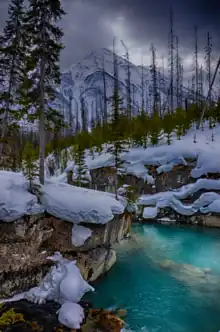| Part of a series on |
| The Burgess Shale |
|---|
 |

Stanley Glacier in November 2017
The Stanley Glacier locality in British Columbia is an exposure of the "thin" Stephen formation exhibiting soft-tissue preservation.[1] Fossils were discovered by a hiker who reported the find to Parks Canada; this brought the site to the attention of scientists who were able to study the site and describe the new biota.[2] The discovery of Burgess Shale-type preservation in the thin Stephen was unexpected, given the absence of the Cathedral escarpment in the area.[1] Several new species, including Stanleycaris, have already been found in exploratory excavations at the site.[1]
References
- 1 2 3 Caron, J. -B.; Gaines, R. R.; Mangano, M. G.; Streng, M.; Daley, A. C. (2010). "A new Burgess Shale-type assemblage from the "thin" Stephen Formation of the southern Canadian Rockies". Geology. 38 (9): 811. Bibcode:2010Geo....38..811C. doi:10.1130/G31080.1.
- ↑ "Burgess-shale-sites-provide-scientists-with-new-finds". Rocky Mountain Outlook.
51°11′17″N 116°03′07″W / 51.188°N 116.052°W
This article is issued from Wikipedia. The text is licensed under Creative Commons - Attribution - Sharealike. Additional terms may apply for the media files.